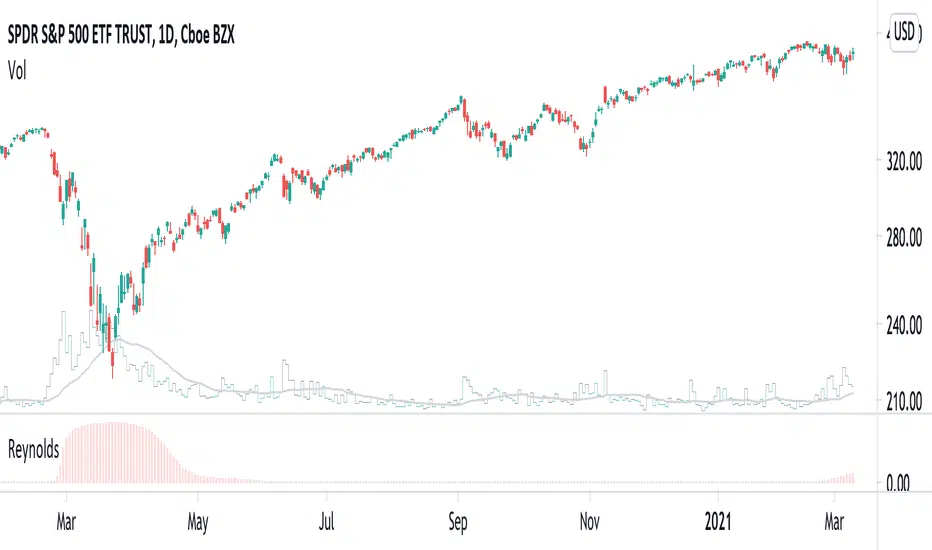OPEN-SOURCE SCRIPT
Reynolds warning rate

In fluid mechanics, the Reynolds number is the ratio of inertial forces to viscous forces within a fluid. Laminar flow occurs at low Reynolds numbers (i.e., viscous forces are dominant), whereas turbulent flow occurs at high Reynolds numbers (i.e., inertial forces are dominant). In the Turbulence indicator, I define that laminar flow occurs when simple moving averages have no interactions. In contrast, turbulent flow occurs when simple moving averages have chaotic interactions (i.e., irregular crossing and convergence).
Here, I calculate an economical analog of the Reynolds number developed by Jakimowicz and Juzwiszyn (2015). Furthermore, I propose the Reynolds Warning Rate, given by a ratio of short- and long-term Reynolds number.
The higher Reynolds Warning Rate indicates that price movement is going to a turbulence phase, and the market is under a possible systemic risk.
Reference:
Jakimowicz A, Juzwiszyn J (2015) Balance in the turbulent world of economy. Acta Physica Polonica A 127, 78–85.
Here, I calculate an economical analog of the Reynolds number developed by Jakimowicz and Juzwiszyn (2015). Furthermore, I propose the Reynolds Warning Rate, given by a ratio of short- and long-term Reynolds number.
The higher Reynolds Warning Rate indicates that price movement is going to a turbulence phase, and the market is under a possible systemic risk.
Reference:
Jakimowicz A, Juzwiszyn J (2015) Balance in the turbulent world of economy. Acta Physica Polonica A 127, 78–85.
Skrypt open-source
W duchu TradingView twórca tego skryptu udostępnił go jako open-source, aby traderzy mogli analizować i weryfikować jego funkcjonalność. Brawo dla autora! Możesz korzystać z niego za darmo, ale pamiętaj, że ponowna publikacja kodu podlega naszym Zasadom Społeczności.
Wyłączenie odpowiedzialności
Informacje i publikacje przygotowane przez TradingView lub jego użytkowników, prezentowane na tej stronie, nie stanowią rekomendacji ani porad handlowych, inwestycyjnych i finansowych i nie powinny być w ten sposób traktowane ani wykorzystywane. Więcej informacji na ten temat znajdziesz w naszym Regulaminie.
Skrypt open-source
W duchu TradingView twórca tego skryptu udostępnił go jako open-source, aby traderzy mogli analizować i weryfikować jego funkcjonalność. Brawo dla autora! Możesz korzystać z niego za darmo, ale pamiętaj, że ponowna publikacja kodu podlega naszym Zasadom Społeczności.
Wyłączenie odpowiedzialności
Informacje i publikacje przygotowane przez TradingView lub jego użytkowników, prezentowane na tej stronie, nie stanowią rekomendacji ani porad handlowych, inwestycyjnych i finansowych i nie powinny być w ten sposób traktowane ani wykorzystywane. Więcej informacji na ten temat znajdziesz w naszym Regulaminie.